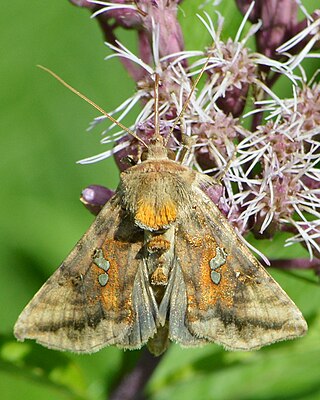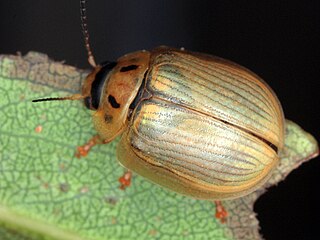
The bimaculated lark breeds in warm temperate countries eastwards from Turkey into Central Asia. It is the eastern counterpart of its relative, the calandra lark.
Tridecane or n-tridecane is an alkane with the chemical formula CH3(CH2)11CH3. Tridecane is a combustible colourless liquid. In industry, they have no specific value aside from being components of various fuels and solvents. In the research laboratory, tridecane is also used as a distillation chaser.

Elaphe bimaculata, the twin-spotted ratsnake or Chinese leopard snake, is a small ratsnake (60–80 cm) found in China. It occurs as both blotched and striped phase, with the blotched type being the more common or "typical" phase. Some specimens even exhibit a pattern of half blotched, half striped where the anterior half is usually blotched and the posterior half striped. They are found in many habitats ranging from the edge of forest to cultivated areas and seem to like cooler temperatures and higher humidity. This secretive snake prefers smaller food items such as young to half grown mice. E. bimaculata has been known to breed at different times of the year, usually with 3-10 eggs being laid in late spring; eggs require 35–48 days of incubation. A period of 2–3 months hibernation is typical. Females are known to grow larger and heavier than males.

Nannacara is a genus of small freshwater cichlid fish endemic to South America. The genus is part of the Cichlasomatini tribe of the Cichlasomatinae subfamily. In the aquarium hobby, the fish is considered a dwarf cichlid along with Apistogramma, Mikrogeophagus, and Dicrossus species. Nannacara anomala is the most commonly encountered species in the aquarium trade.
Acanthopteroctetidae is a small family of primitive moths with two described genera, Acanthopteroctetes and Catapterix, and a total of seven described species. They are known as the archaic sun moths.

The white-rumped robin is a species of bird in the family Petroicidae. It is found in New Guinea. Its natural habitats are subtropical or tropical moist lowland forests and subtropical or tropical moist montane forests.

Venericardia is a widely distributed genus of marine bivalve molluscs, in the family Carditidae.

Lomographa bimaculata, the white-pinion spotted, is a species of geometer moth. It belongs to the large geometer moth subfamily Ennominae, and therein to the tribe Baptini. It is – under its junior synonym – the type species of its genus Lomographa. It is also the type species of Bapta, a junior objective synonym of Lomographa and the namesake of the Baptini. The species was first described by Johan Christian Fabricius ion 1775.

Autographa bimaculata, the two-spotted looper moth, twin gold spot or double-spotted spangle, is a moth of the family Noctuidae. The species was first described by James Francis Stephens in 1830. It is found in North America from Newfoundland west, just short of the coast of British Columbia, north to the Northwest Territories and south to New Mexico in the west and Pennsylvania and Long Island in the east.
Margovula bimaculata is a species of sea snail, a marine gastropod mollusk in the family Ovulidae, the ovulids, cowry allies or false cowries.

Opharus bimaculata is a moth of the family Erebidae. It was described by Hermann Dewitz in 1877. It is found in Puerto Rico, Guatemala, Costa Rica, Honduras, Venezuela and Brazil.
Phaneta bimaculata is a species of moth of the family Tortricidae. It is found in China (Jiangxi), Japan and the Russian Far East.
Mimodesisa is a genus of longhorn beetles of the subfamily Lamiinae, containing the following species:

Glycymeris bimaculata is a marine bivalve mollusc in the family Glycymerididae.

Paropsisterna bimaculata is a beetle commonly called a leaf beetle in the subfamily Chrysomelinae.This insect is common in Tasmania and can be a pest in the forestry industry. Paropsisterna bimaculata will develop a red color just before their winter hibernation. When they emerge the red slowly disappears into a pale green colouring with faint gold tessellation. This takes about a month with the males generally slightly advanced. Recently this beetle has been noticed in Victoria.

Uraecha bimaculata is a species of beetle in the family Cerambycidae. It was described by James Thomson in 1864.
Mimodesisa affinis is a species of beetle in the family Cerambycidae. It was described by Stephan von Breuning in 1942.
Mimodesisa albofasciculata is a species of beetle in the family Cerambycidae. It was described by Stephan von Breuning in 1969.

Diplecogaster bimaculata, the two-spotted clingfish, is a species of fish in the family Gobiesocidae found in Black Sea, Mediterranean Sea and Atlantic Ocean where it is found on rocks and among seagrass or shell beds.

Neottiura bimaculata is a species of cobweb spider in the family Theridiidae. It is found in North America, Europe, Turkey, Caucasus, Russia (Siberia), Central Asia, China, and Japan.












